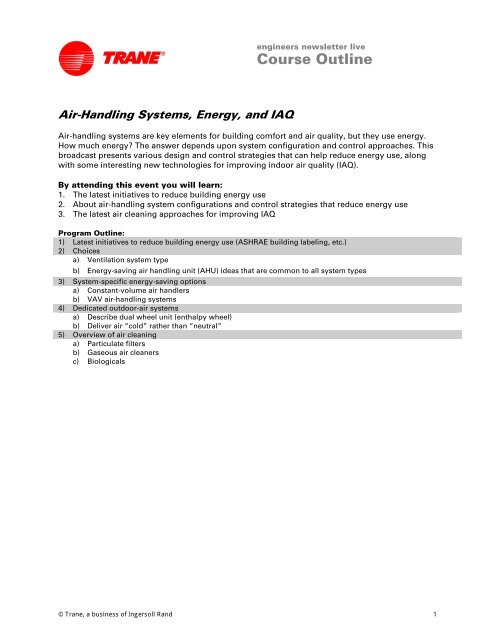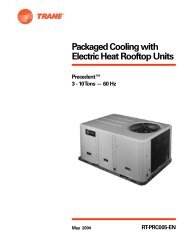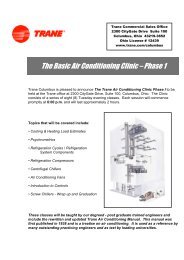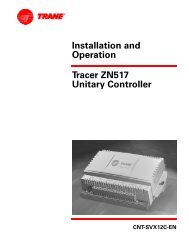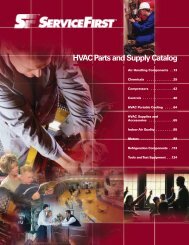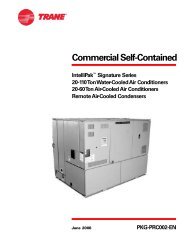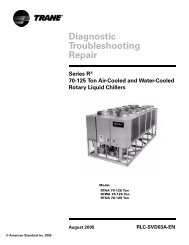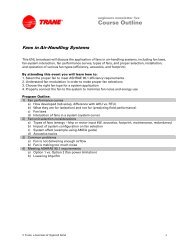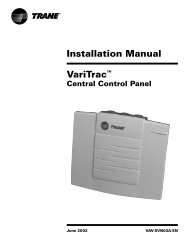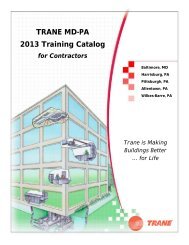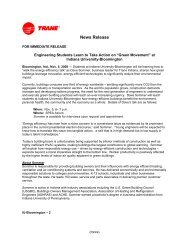Air-Handling Systems, Energy, and IAQ - Trane
Air-Handling Systems, Energy, and IAQ - Trane
Air-Handling Systems, Energy, and IAQ - Trane
Create successful ePaper yourself
Turn your PDF publications into a flip-book with our unique Google optimized e-Paper software.
<strong>Air</strong>-<strong>H<strong>and</strong>ling</strong> <strong>Systems</strong>, <strong>Energy</strong>, <strong>and</strong> <strong>IAQ</strong><br />
engineers newsletter live<br />
Course Outline<br />
<strong>Air</strong>-h<strong>and</strong>ling systems are key elements for building comfort <strong>and</strong> air quality, but they use energy.<br />
How much energy? The answer depends upon system configuration <strong>and</strong> control approaches. This<br />
broadcast presents various design <strong>and</strong> control strategies that can help reduce energy use, along<br />
with some interesting new technologies for improving indoor air quality (<strong>IAQ</strong>).<br />
By attending this event you will learn:<br />
1. The latest initiatives to reduce building energy use<br />
2. About air-h<strong>and</strong>ling system configurations <strong>and</strong> control strategies that reduce energy use<br />
3. The latest air cleaning approaches for improving <strong>IAQ</strong><br />
Program Outline:<br />
1) Latest initiatives to reduce building energy use (ASHRAE building labeling, etc.)<br />
2) Choices<br />
a) Ventilation system type<br />
b) <strong>Energy</strong>-saving air h<strong>and</strong>ling unit (AHU) ideas that are common to all system types<br />
3) System-specific energy-saving options<br />
a) Constant-volume air h<strong>and</strong>lers<br />
b) VAV air-h<strong>and</strong>ling systems<br />
4) Dedicated outdoor-air systems<br />
a) Describe dual wheel unit (enthalpy wheel)<br />
b) Deliver air “cold” rather than “neutral”<br />
5) Overview of air cleaning<br />
a) Particulate filters<br />
b) Gaseous air cleaners<br />
c) Biologicals<br />
© <strong>Trane</strong>, a business of Ingersoll R<strong>and</strong> 1
<strong>Air</strong>-<strong>H<strong>and</strong>ling</strong> <strong>Systems</strong>, <strong>Energy</strong> <strong>and</strong> <strong>IAQ</strong><br />
engineers newsletter live<br />
Presenter Biographies<br />
Art Hallstrom | Team Leader, Applied System Specialist | <strong>Trane</strong><br />
Art has more than 35 years of industry experience working with innovative systems <strong>and</strong> products.<br />
Currently he heads up a support team of system specialists to develop innovative solutions to<br />
challenging projects. Art has created over 30 applications manuals <strong>and</strong> articles on subjects like<br />
electronic noise cancellation, building pressurization, <strong>and</strong> static regain duct design. Art is a PE,<br />
ASHRAE Fellow <strong>and</strong> is serves on the ASHRAE Technical Council. He is a former Director of<br />
ASHRAE <strong>and</strong> a Past President of the ASHRAE College of Fellows. He is a retired U.S. Army LTC, a<br />
commercial pilot, an advanced SCUBA diver, <strong>and</strong> licensed sailboat skipper.<br />
Dennis Stanke | staff application engineer | <strong>Trane</strong><br />
With a BSME from the University of Wisconsin, Dennis joined <strong>Trane</strong> in 1973, as a controls<br />
development engineer. He is now a Staff Applications Engineer specializing in airside systems<br />
including controls, ventilation, indoor air quality, <strong>and</strong> dehumidification. He has written numerous<br />
applications manuals <strong>and</strong> newsletters, has published many technical articles <strong>and</strong> columns, <strong>and</strong><br />
has appeared in many <strong>Trane</strong> Engineers Newsletter Live broadcasts.<br />
An ASHRAE Fellow, he is currently Chairman for SSPC62.1, the ASHRAE committee responsible<br />
for St<strong>and</strong>ard 62.1, “Ventilation for Acceptable Indoor <strong>Air</strong> Quality,” <strong>and</strong> he serves on the USGBC<br />
LEED Technical Advisory Group for Indoor Environmental Quality (the LEED EQ TAG).<br />
John Murphy | senior applications engineer | <strong>Trane</strong><br />
John has been with <strong>Trane</strong> since 1993. His primary responsibility as an applications engineer is to<br />
aid design engineers <strong>and</strong> <strong>Trane</strong> sales personnel in the proper design <strong>and</strong> application of HVAC<br />
systems. As a LEED Accredited Professional, he has helped our customers <strong>and</strong> local offices on a<br />
wide range of LEED projects. His main areas of expertise include dehumidification, air-to-air<br />
energy recovery, psychrometry, ventilation, <strong>and</strong> ASHRAE St<strong>and</strong>ards 15, 62.1, <strong>and</strong> 90.1.<br />
John is the author of numerous <strong>Trane</strong> application manuals <strong>and</strong> Engineers Newsletters, <strong>and</strong> is a<br />
frequent presenter on <strong>Trane</strong>’s Engineers Newsletter Live series of broadcasts. He also is a member<br />
of ASHRAE, has authored several articles for the ASHRAE Journal, <strong>and</strong> is a member of ASHRAE’s<br />
“Moisture Management in Buildings” <strong>and</strong> “Mechanical Dehumidifiers” technical committees.<br />
© <strong>Trane</strong>, a business of Ingersoll R<strong>and</strong> 2
© 2008 <strong>Trane</strong> Inc.<br />
2<br />
<strong>Air</strong>-<strong>H<strong>and</strong>ling</strong> <strong>Systems</strong>,<br />
<strong>Energy</strong> <strong>and</strong> <strong>IAQ</strong><br />
© 2009 <strong>Trane</strong><br />
Engineers<br />
Newsletter Live<br />
� “<strong>Trane</strong>” is a Registered Provider with The American Institute<br />
of Architects Continuing Education <strong>Systems</strong>. Credit earned on<br />
completion of this program will be reported to CES Records for<br />
AIA members. Certificates of Completion for non-AIA members<br />
available on request.<br />
� This program is registered with the AIA/CES for continuing<br />
professional education. As such, it does not include content that<br />
may be deemed or construed to be an approval or endorsement<br />
by the AIA of any material of construction or any method or<br />
manner of h<strong>and</strong>ling, using, distributing, or<br />
dealing in any material or product.<br />
Questions related to specific materials,<br />
methods, <strong>and</strong> services will be addressed<br />
at the conclusion of this presentation.<br />
© <strong>Trane</strong>, a business of Ingersoll R<strong>and</strong> 3
Copyrighted Materials<br />
This presentation is protected by U.S. <strong>and</strong> international<br />
copyright laws. Reproduction, distribution, display, <strong>and</strong><br />
use of the presentation without written permission of<br />
<strong>Trane</strong> is prohibited.<br />
© 2009 <strong>Trane</strong>, Inc. All rights reserved.<br />
3<br />
© 2009 <strong>Trane</strong><br />
<strong>Air</strong>-<strong>H<strong>and</strong>ling</strong> <strong>Systems</strong>, <strong>Energy</strong> <strong>and</strong> <strong>IAQ</strong><br />
Today’s Topics<br />
� Latest initiatives to reduce building energy use<br />
� <strong>Energy</strong>-saving ideas for air-h<strong>and</strong>ling systems<br />
• Constant-volume air-h<strong>and</strong>ling units<br />
• VAV air-h<strong>and</strong>ling systems<br />
� High-performance dedicated outdoor-air systems<br />
� Overview of air cleaning technologies<br />
4<br />
© 2009 <strong>Trane</strong><br />
© <strong>Trane</strong>, a business of Ingersoll R<strong>and</strong> 4
Today’s Presenters<br />
5<br />
6<br />
Art Hallstrom<br />
Manager, Applied<br />
System Specialists<br />
© 2009 <strong>Trane</strong><br />
© 2009 <strong>Trane</strong><br />
John Murphy<br />
Applications<br />
Engineer<br />
Dennis Stanke<br />
Staff Applications<br />
Engineer<br />
Why Buildings’ <strong>Energy</strong> Use is Important<br />
• Largest energy consumer in the U.S.<br />
• 40% of primary energy consumption<br />
• 72% of U.S. electricity<br />
• 55% of U.S. natural gas<br />
Industry<br />
32%<br />
Transportation<br />
28%<br />
22%<br />
Residential<br />
Buildings<br />
40%<br />
18%<br />
Commercial<br />
computers 1%<br />
cooking 5%<br />
electronics 7%<br />
wet clean 5%<br />
refrigeration 8%<br />
cooling 12%<br />
lights 11%<br />
water heat 12%<br />
heating 31%<br />
other 4%<br />
cooking 2%<br />
computers 3%<br />
refrigeration 4%<br />
office equipment 6%<br />
ventilation 6%<br />
water Heat 7%<br />
cooling 13%<br />
heating 14%<br />
lights 26%<br />
other 13%<br />
Source: National Renewable <strong>Energy</strong> Lab<br />
© <strong>Trane</strong>, a business of Ingersoll R<strong>and</strong> 5
The Case for Sustainable Buildings<br />
Average <strong>Energy</strong> Consumption in<br />
Commercial Buildings<br />
7<br />
© 2009 <strong>Trane</strong><br />
HVACR<br />
30%<br />
Lighting<br />
39%<br />
Source: E Source, Inc.<br />
<strong>Air</strong>-<strong>H<strong>and</strong>ling</strong> <strong>Systems</strong>,<br />
<strong>Energy</strong> <strong>and</strong> <strong>IAQ</strong><br />
Other<br />
17%<br />
Office equipment<br />
8%<br />
Water heat 8%<br />
Cooking 1%<br />
Latest Initiatives<br />
for Reducing<br />
Building <strong>Energy</strong> Use<br />
© <strong>Trane</strong>, a business of Ingersoll R<strong>and</strong> 6
Balancing <strong>IAQ</strong> <strong>and</strong> <strong>Energy</strong><br />
� Building performance metrics<br />
9<br />
• <strong>Energy</strong>, water use<br />
• Thermal comfort<br />
• <strong>IAQ</strong><br />
• Lighting<br />
• Noise<br />
� Building energy use<br />
• <strong>Energy</strong> Use Intensity (EUI) - kBtu/ft2-yr • Every building has this metric<br />
10<br />
© 2009 <strong>Trane</strong><br />
Building <strong>Energy</strong> Rating Methods<br />
� Two groups<br />
• Environmental <strong>and</strong> <strong>Energy</strong><br />
� LEED ®<br />
� ASHRAE 189.1 <strong>and</strong> 189.2<br />
• <strong>Energy</strong> Only<br />
� EPA (DOE) (<strong>Energy</strong> Star®)<br />
� ASHRAE Building EQ<br />
� State St<strong>and</strong>ards (CA Title 24)<br />
� CIBSE (Chartered Institution of Building Services<br />
Engineers)<br />
© 2009 <strong>Trane</strong><br />
© <strong>Trane</strong>, a business of Ingersoll R<strong>and</strong> 7
11<br />
12<br />
© 2009 <strong>Trane</strong><br />
© 2009 <strong>Trane</strong><br />
ASHRAE<br />
Building <strong>Energy</strong> Quotient<br />
� Technically sound<br />
� Developed with<br />
international input<br />
� In pilot phase<br />
As designed<br />
As operated<br />
ASHRAE/EPA Label Comparison<br />
ASHRAE Building EQ<br />
(Percentage based on ratio of EUI building/EUI median)<br />
F<br />
Unsatisfactory<br />
D<br />
Poor<br />
1 15 30 50 75 100<br />
<strong>Energy</strong> Star Award<br />
EPA <strong>Energy</strong> Star<br />
(Percentage based on EUI<br />
distribution in actual building stock)<br />
C<br />
Fair<br />
B<br />
Good<br />
A-<br />
Very<br />
Good<br />
A<br />
High<br />
Perform<br />
150 125 100 75 50 25 0<br />
A+<br />
Net Zero<br />
© <strong>Trane</strong>, a business of Ingersoll R<strong>and</strong> 8
ASHRAE Std 90.1 Moves Toward Net-Zero<br />
13<br />
Building EQ<br />
100<br />
80<br />
60<br />
40<br />
20<br />
© 2009 <strong>Trane</strong><br />
ASHRAE 90.1-1999<br />
ASHRAE 90.1-2004<br />
ASHRAE 90.1-2007<br />
ASHRAE 90.1-2010?<br />
Net Zero<br />
<strong>Air</strong>-<strong>H<strong>and</strong>ling</strong> <strong>Systems</strong>,<br />
<strong>Energy</strong> <strong>and</strong> <strong>IAQ</strong><br />
Building Stock Median<br />
LEED<br />
2009<br />
LEED<br />
2.2<br />
LEED<br />
2.1<br />
<strong>Energy</strong>-Saving<br />
Strategies for<br />
<strong>Air</strong>-<strong>H<strong>and</strong>ling</strong> <strong>Systems</strong><br />
© <strong>Trane</strong>, a business of Ingersoll R<strong>and</strong> 9
<strong>Energy</strong>-Saving Ideas<br />
Common to All System Types<br />
� Reduce airside pressure loss<br />
• Less airflow (i.e., colder air)<br />
• Less resistance (bigger ducts, bigger ahu, right coils)<br />
� Use high-efficiency fans (if you have a choice)<br />
� Consider air-to-air energy recovery<br />
� Use factory-supplied operating controls<br />
• To coordinate (e.g., reduce simultaneous<br />
heating/cooling)<br />
• To optimize (e.g., dem<strong>and</strong>-controlled ventilation)<br />
15<br />
16<br />
© 2009 <strong>Trane</strong><br />
Reduce <strong>Air</strong>side Pressure Loss<br />
© 2009 <strong>Trane</strong><br />
3.5 hp<br />
7 hp<br />
3<br />
4<br />
© <strong>Trane</strong>, a business of Ingersoll R<strong>and</strong> 10<br />
1<br />
2<br />
3 hp<br />
6 hp
Consider <strong>Air</strong>-to-<strong>Air</strong> <strong>Energy</strong> Recovery<br />
17<br />
18<br />
EA<br />
Summer<br />
• sensible heat<br />
• water vapor<br />
OA<br />
© 2009 <strong>Trane</strong><br />
© 2009 <strong>Trane</strong><br />
total-energy<br />
wheel<br />
Winter<br />
• sensible heat<br />
• water vapor<br />
Employ Dem<strong>and</strong>-Controlled Ventilation<br />
� At design, minimum intake airflow (Vbz):<br />
Vbz = Rp*Pz + Ra*Az<br />
= 7.5*260 + 0.06*4000 = 2190 cfm<br />
Qoa = about 4 tons<br />
� At part load, if Pz = 130<br />
Vbz = 7.5*130 + 0.6*4000 = 1215 cfm<br />
Qoa = less than 2 tons<br />
� Zone-level DCV<br />
• Saves energy at part load<br />
• Required by Std 90.1 (Section 6.4.3.9) for zones with<br />
more than 40 people/1000 ft 2<br />
© <strong>Trane</strong>, a business of Ingersoll R<strong>and</strong> 11
<strong>Energy</strong>-Saving Strategies for<br />
<strong>Air</strong>-<strong>H<strong>and</strong>ling</strong> <strong>Systems</strong><br />
� Reduce pressure loss<br />
• Less supply airflow<br />
• Less distribution system pressure drop<br />
� Recover total energy (both sensible <strong>and</strong> latent)<br />
� Use controls to your advantage<br />
• Coordinate (eliminate simultaneous heating/cooling)<br />
• Optimize (for instance, dem<strong>and</strong> controlled ventilation)<br />
19<br />
© 2009 <strong>Trane</strong><br />
<strong>Air</strong>-<strong>H<strong>and</strong>ling</strong> <strong>Systems</strong>,<br />
<strong>Energy</strong> <strong>and</strong> <strong>IAQ</strong><br />
<strong>Energy</strong> Strategies for<br />
Single-Zone<br />
<strong>Systems</strong><br />
© <strong>Trane</strong>, a business of Ingersoll R<strong>and</strong> 12
<strong>Energy</strong>-Saving Ideas<br />
For Specific System Types<br />
� Constant-volume, air-h<strong>and</strong>ling units (single-zone)<br />
� VAV air-h<strong>and</strong>ling systems (multiple-zone)<br />
� Dedicated outdoor air systems (100% outdoor air)<br />
21<br />
22<br />
© 2009 <strong>Trane</strong><br />
constant volume (CV)<br />
Basic System<br />
OA<br />
© 2009 <strong>Trane</strong><br />
MA<br />
C<br />
RA<br />
constantspeed<br />
fan<br />
SA<br />
T<br />
space<br />
zone temperature determines AHU cooling capacity<br />
© <strong>Trane</strong>, a business of Ingersoll R<strong>and</strong> 13<br />
EA
<strong>Energy</strong>-Saving Ideas<br />
For Constant-Volume <strong>Air</strong>-<strong>H<strong>and</strong>ling</strong> Units<br />
� Change to single-zone VAV control<br />
� Use a dual-path AHU configuration<br />
(split dehumidification unit, SDU)<br />
� Add a series Type III desiccant wheel<br />
for low dew point applications<br />
23<br />
© 2009 <strong>Trane</strong><br />
Single-Zone, Constant-Volume System<br />
EA<br />
OA<br />
24<br />
© 2009 <strong>Trane</strong><br />
RA<br />
constant-speed<br />
supply fan<br />
T<br />
SA<br />
space<br />
© <strong>Trane</strong>, a business of Ingersoll R<strong>and</strong> 14
Single-Zone VAV System<br />
EA<br />
OA<br />
25<br />
© 2009 <strong>Trane</strong><br />
single-zone VAV<br />
Benefits<br />
26<br />
© 2009 <strong>Trane</strong><br />
variable-speed<br />
supply fan<br />
RA<br />
T<br />
T<br />
SA<br />
space<br />
� Lower operating cost by reducing fan speed<br />
at part load<br />
� Reduced sound levels at part load<br />
� Improved dehumidification since the system<br />
continues to supply cool, dry air at part load<br />
� Typical applications: larger zones with variable<br />
occupancy (gymnasiums, cafeterias, lecture<br />
halls, auditoriums, churches, arenas)<br />
© <strong>Trane</strong>, a business of Ingersoll R<strong>and</strong> 15
Single-Zone VAV System<br />
EA<br />
flow-measuring<br />
OA damper<br />
OA<br />
27<br />
28<br />
© 2009 <strong>Trane</strong><br />
© 2009 <strong>Trane</strong><br />
RA<br />
T<br />
T<br />
SA<br />
space<br />
P<br />
CO 2<br />
Change for ASHRAE 90.1-2010<br />
� 6.4.3.10 Single Zone VAV Control<br />
• Effective January 1, 2010, air-h<strong>and</strong>ling <strong>and</strong> fan-coil<br />
units with chilled-water cooling coils <strong>and</strong> supply fans<br />
with motors greater than or equal to 5 hp shall have their<br />
supply fans controlled by two-speed motors or variablespeed<br />
drives.<br />
• At cooling dem<strong>and</strong>s less than or equal to 50%, the<br />
supply fan controls shall be able to reduce the airflow to<br />
no greater than the larger of the following:<br />
1. One half of the full fan speed, or<br />
2. The volume of outdoor air required to meet the<br />
ventilation requirements of St<strong>and</strong>ard 62.1.<br />
© <strong>Trane</strong>, a business of Ingersoll R<strong>and</strong> 16
<strong>Energy</strong>-Saving Ideas<br />
For Constant-Volume <strong>Air</strong>-<strong>H<strong>and</strong>ling</strong> Units<br />
29<br />
RH<br />
T<br />
� Change to single-zone VAV control<br />
� Use a dual-path AHU configuration<br />
(split dehumidification unit, SDU)<br />
� Add a series Type III desiccant wheel<br />
for low dew point applications<br />
30<br />
© 2009 <strong>Trane</strong><br />
Split Dehumidification Unit (SDU)<br />
© 2009 <strong>Trane</strong><br />
SA<br />
OA cooling coil<br />
RA cooling coil<br />
© <strong>Trane</strong>, a business of Ingersoll R<strong>and</strong> 17<br />
OA<br />
RA
split dehumidification unit<br />
Benefits<br />
� Improved dehumidification performance<br />
� Smaller footprint since bottom coil module is sized<br />
for recirculated air only (not mixed air)<br />
• or keep same footprint <strong>and</strong> reduce fan power<br />
� Typical applications: larger zones in non-arid climates<br />
31<br />
© 2009 <strong>Trane</strong><br />
<strong>Energy</strong>-Saving Ideas<br />
For Constant-Volume <strong>Air</strong>-<strong>H<strong>and</strong>ling</strong> Units<br />
� Change to single-zone VAV control<br />
� Use a dual-path AHU configuration<br />
(split dehumidification unit, SDU)<br />
� Add a series Type III desiccant wheel<br />
for low dew point applications<br />
32<br />
© 2009 <strong>Trane</strong><br />
© <strong>Trane</strong>, a business of Ingersoll R<strong>and</strong> 18
Series Type III Desiccant Wheel<br />
33<br />
34<br />
cooling<br />
coil<br />
© 2009 <strong>Trane</strong><br />
© 2009 <strong>Trane</strong><br />
76°F DB<br />
59°F DP<br />
MA'<br />
CA<br />
51°F DB<br />
49°F DP<br />
water vapor<br />
80°F DB<br />
54°F DP<br />
MA<br />
55°F DB<br />
42°F DP<br />
Type III<br />
desiccant wheel<br />
series Type III desiccant wheel<br />
How It Works<br />
high<br />
ability to hold water vapor<br />
Type I<br />
typical<br />
entering-coil<br />
conditions<br />
Type II<br />
Type III desiccant<br />
low<br />
0 20 40 60 80 100<br />
relative humidity, %<br />
OA<br />
RA<br />
SA<br />
typical<br />
leaving-coil<br />
conditions<br />
© <strong>Trane</strong>, a business of Ingersoll R<strong>and</strong> 19
OA 100°F DB<br />
74°F WB<br />
RA 62°F DB<br />
50% RH<br />
MA 80°F DB<br />
54°F DP<br />
MA' 76°F DB<br />
59°F DP<br />
CA 51°F DB<br />
49°F DP<br />
SA 55°F DB<br />
42°F DP<br />
35<br />
30<br />
30 40 50 60 70 80 90 100<br />
dry-bulb temperature, °F<br />
© 2009 <strong>Trane</strong><br />
CA<br />
50<br />
40<br />
CAreheat MA'<br />
CA<br />
60<br />
70<br />
wet-bulb temperature, °F<br />
SA<br />
series wheel requires:<br />
• less cooling tons<br />
• no reheat<br />
• warmer coil temp<br />
… than Cool + Reheat<br />
36<br />
30<br />
© 2009 <strong>Trane</strong><br />
51°F<br />
50<br />
43°F<br />
40<br />
CA reheat<br />
CA<br />
MA<br />
RA<br />
OA<br />
80<br />
RA<br />
SA<br />
MA'<br />
MA<br />
surgery room example<br />
60<br />
OA<br />
30 40 50 60 70 80 90 100<br />
dry-bulb temperature, °F<br />
Series Desiccant Wheel vs. Cool + Reheat<br />
70<br />
wet-bulb temperature, °F<br />
SA<br />
RA<br />
© <strong>Trane</strong>, a business of Ingersoll R<strong>and</strong> 20<br />
80<br />
MA'<br />
MA<br />
OA<br />
110<br />
180<br />
160<br />
140<br />
120<br />
100<br />
80<br />
60<br />
40<br />
20<br />
110<br />
180<br />
160<br />
140<br />
120<br />
100<br />
80<br />
60<br />
40<br />
20<br />
humidity ratio, grains/lb of dry air<br />
humidity ratio, grains/lb of dry air
series Type III desiccant wheel<br />
Benefits<br />
� Extends the application of mechanical<br />
(vapor-compression) cooling equipment<br />
• Lowers achievable dew point by 5°F to 10°F<br />
� Uses less energy than cooling plus reheat<br />
• Less cooling tons, no reheat, warmer coil temperature<br />
� Does not require a separate exhaust airstream<br />
• It is NOT exhaust-air energy recovery<br />
� Typical applications: zones that require lower dew<br />
points (surgery rooms, supermarkets, laboratories,<br />
pharmacies, libraries, museums, archive storage)<br />
37<br />
© 2009 <strong>Trane</strong><br />
<strong>Air</strong>-<strong>H<strong>and</strong>ling</strong> <strong>Systems</strong>,<br />
<strong>Energy</strong> <strong>and</strong> <strong>IAQ</strong><br />
<strong>Energy</strong> Strategies for<br />
VAV Multiple-Zone<br />
<strong>Systems</strong><br />
© <strong>Trane</strong>, a business of Ingersoll R<strong>and</strong> 21
<strong>Energy</strong>-Saving Ideas<br />
Specific to System Types<br />
� Constant-volume air-h<strong>and</strong>ling units (single-zone)<br />
� VAV air-h<strong>and</strong>ling systems (multiple-zone)<br />
� Dedicated outdoor air systems (100% outdoor air)<br />
39<br />
40<br />
© 2009 <strong>Trane</strong><br />
Multiple-Zone VAV<br />
© 2009 <strong>Trane</strong><br />
EA<br />
RA<br />
OA MA T SA<br />
supply air temp<br />
determines AHU<br />
cooling capacity<br />
variablespeed<br />
fan<br />
space<br />
space<br />
© <strong>Trane</strong>, a business of Ingersoll R<strong>and</strong> 22<br />
T<br />
T
Optimized VAV System Controls<br />
� Optimal start/stop<br />
� Time-of-day scheduling<br />
� Fan-pressure optimization<br />
� Supply-air-temperature reset<br />
� Ventilation optimization<br />
• Dem<strong>and</strong>-controlled ventilation at zone level<br />
• Ventilation reset at system level (<strong>and</strong> TRAQ dampers)<br />
� Return fan control<br />
� Building pressure control<br />
41<br />
© 2009 <strong>Trane</strong><br />
Traditional VAV Fan Control<br />
42<br />
supply<br />
fan<br />
© 2009 <strong>Trane</strong><br />
static<br />
pressure<br />
sensor<br />
P<br />
VAV boxes<br />
© <strong>Trane</strong>, a business of Ingersoll R<strong>and</strong> 23
Fan-Pressure Optimization<br />
43<br />
supply<br />
fan<br />
© 2009 <strong>Trane</strong><br />
static<br />
pressure<br />
sensor<br />
communicating BAS<br />
fan-pressure optimization<br />
Part-Load <strong>Energy</strong> Savings<br />
44<br />
static pressure<br />
1 in.wc.<br />
© 2009 <strong>Trane</strong><br />
surge<br />
energy savings<br />
input power<br />
duct static<br />
pressure control<br />
fan-pressure<br />
optimization<br />
airflow<br />
800 rpm<br />
P<br />
900 rpm<br />
VAV boxes<br />
1000 rpm<br />
© <strong>Trane</strong>, a business of Ingersoll R<strong>and</strong> 24
Fan-Pressure Optimization<br />
45<br />
supply<br />
fan<br />
© 2009 <strong>Trane</strong><br />
static<br />
pressure<br />
sensor<br />
P<br />
communicating BAS<br />
fan-pressure optimization<br />
Benefits<br />
� Part-load energy savings<br />
� Lower sound levels<br />
� Better zone control<br />
� Less duct leakage<br />
� Reduced risk of fan surge<br />
� Factory-installation <strong>and</strong> -commissioning<br />
of duct pressure sensor<br />
� Operator feedback to "tune the system"<br />
46<br />
© 2009 <strong>Trane</strong><br />
VAV boxes<br />
© <strong>Trane</strong>, a business of Ingersoll R<strong>and</strong> 25
dem<strong>and</strong>-controlled ventilation<br />
CO 2 Sensor in Every Zone?<br />
47<br />
© 2009 <strong>Trane</strong><br />
lounge rest<br />
room<br />
CO 2<br />
vestibule corridor<br />
CO2 reception area elevators<br />
ventilation optimization<br />
Zone Level: DCV<br />
48<br />
© 2009 <strong>Trane</strong><br />
lounge rest<br />
room<br />
CO 2<br />
vestibule corridor<br />
CO 2<br />
AHU<br />
communicating<br />
BAS<br />
storage office<br />
CO 2<br />
CO 2<br />
CO 2<br />
office conference rm computer room<br />
AHU<br />
communicating<br />
BAS<br />
storage office<br />
OCC<br />
TOD TOD<br />
OCC<br />
CO2 reception area elevators<br />
office conference rm computer room<br />
© <strong>Trane</strong>, a business of Ingersoll R<strong>and</strong> 26
ventilation optimization<br />
System Level: Ventilation Reset<br />
49<br />
© 2009 <strong>Trane</strong><br />
SA RA<br />
OA<br />
air-h<strong>and</strong>ling unit with<br />
flow-measuring OA damper<br />
• Reset outdoor airflow<br />
CO2 TOD OCC TOD OCC<br />
communicating BAS<br />
•New OA setpoint<br />
…per ASHRAE 62<br />
ventilation optimization<br />
Benefits<br />
50<br />
© 2009 <strong>Trane</strong><br />
CO 2<br />
DDC VAV controllers<br />
• Required ventilation (TOD, OCC, CO2 )<br />
• Actual primary airflow (flow ring)<br />
� Saves energy during partial occupancy<br />
� Lower installed cost, less maintenance, <strong>and</strong> more<br />
reliable than installing a CO 2 sensor in every zone<br />
• Use zone-level DCV approaches where they best fit<br />
(CO 2 sensor, occupancy sensor, time-of-day schedule)<br />
• Combine with ventilation reset at the system level<br />
� Earn LEED EQc1: Outdoor <strong>Air</strong> Delivery Monitoring<br />
© <strong>Trane</strong>, a business of Ingersoll R<strong>and</strong> 27
HVAC energy use, % of base<br />
Example TRACE ® 700 Analysis<br />
Optimized VAV system controls<br />
� Optimal start<br />
� Fan-pressure optimization<br />
� SA temperature reset<br />
� Ventilation optimization<br />
• DCV at zone level<br />
• Ventilation reset at system level<br />
51<br />
52<br />
© 2009 <strong>Trane</strong><br />
VAV system<br />
<strong>Energy</strong> Savings Via Optimized Controls<br />
100<br />
80<br />
60<br />
40<br />
20<br />
0<br />
© 2009 <strong>Trane</strong><br />
�9%<br />
�11%<br />
�17% �18%<br />
Houston Los Angeles Philadelphia St. Louis<br />
typical system<br />
typical system<br />
with optimized controls<br />
© <strong>Trane</strong>, a business of Ingersoll R<strong>and</strong> 28
Lower Supply-<strong>Air</strong> Temperature<br />
� Benefits<br />
• Reduces supply airflow<br />
� Less supply fan energy<br />
� Smaller fans, air h<strong>and</strong>lers,<br />
VAV terminals, <strong>and</strong> ductwork<br />
• Lowers indoor humidity levels<br />
� Drawbacks<br />
• Increases reheat energy<br />
• Fewer hours when economizer<br />
provides all necessary cooling<br />
(compressors shut off)<br />
53<br />
© 2009 <strong>Trane</strong><br />
lower supply-air temperature<br />
Maximize <strong>Energy</strong> Savings<br />
� Use supply-air temperature reset<br />
• Maximizes benefit of airside economizer<br />
• Reduces reheat energy use<br />
� Raise space setpoint by 1°F or 2°F<br />
• Further reduces airflow <strong>and</strong> fan energy use<br />
� Keep same size ductwork<br />
• Further reduces fan energy use<br />
• Allows SAT reset in systems that serve<br />
zones with near-constant cooling loads<br />
• Capable of delivering more airflow if<br />
loads increase in the future<br />
54<br />
© 2009 <strong>Trane</strong><br />
© <strong>Trane</strong>, a business of Ingersoll R<strong>and</strong> 29
lower supply-air temperature<br />
Challenges<br />
� Minimize comfort problems<br />
due to “dumping”<br />
� Avoid condensation on air<br />
distribution system components<br />
55<br />
© 2009 <strong>Trane</strong><br />
lower supply-air temperature<br />
Minimizing Comfort Problems (Dumping)<br />
� Use linear slot diffusers…<br />
56<br />
© 2009 <strong>Trane</strong><br />
linear slot<br />
diffuser<br />
“dumping”<br />
conventional<br />
concentric diffuser<br />
© <strong>Trane</strong>, a business of Ingersoll R<strong>and</strong> 30
lower supply-air temperature<br />
Minimizing Comfort Problems (Dumping)<br />
…or use fan-powered VAV terminals as “air blenders”<br />
primary air<br />
(45°F)<br />
57<br />
parallel fan-powered<br />
VAV terminal<br />
© 2009 <strong>Trane</strong><br />
plenum air<br />
(80°F)<br />
supply air<br />
(55°F)<br />
lower supply-air temperature<br />
Avoiding Condensation<br />
58<br />
© 2009 <strong>Trane</strong><br />
primary air<br />
(45°F)<br />
plenum air<br />
(80°F)<br />
supply air<br />
(55°F)<br />
series fan-powered<br />
VAV terminal<br />
� Properly insulate <strong>and</strong> vapor-seal<br />
ductwork, VAV terminals, <strong>and</strong> supply-air diffusers<br />
� Use an open ceiling plenum return, if possible<br />
� Maintain positive building pressure to minimize<br />
infiltration of humid outdoor air<br />
� Monitor indoor humidity during unoccupied periods<br />
<strong>and</strong> prevent it from rising too high<br />
� During startup, slowly ramp down the supply-air<br />
temperature to pull down indoor humidity<br />
� Use linear slot diffusers to increase air motion<br />
© <strong>Trane</strong>, a business of Ingersoll R<strong>and</strong> 31
HVAC energy use, % of base<br />
High-Performance CHW-VAV System<br />
59<br />
60<br />
100<br />
80<br />
60<br />
40<br />
20<br />
0<br />
© 2009 <strong>Trane</strong><br />
�9%<br />
�53%<br />
�11%<br />
�36%<br />
�17% �18%<br />
�55%<br />
Houston Los Angeles Philadelphia St. Louis<br />
�54%<br />
typical system typical system<br />
high-performance system<br />
with optimized controls with optimized controls<br />
High-Performance CHW-VAV System<br />
� Cold-air distribution (48°F supply-air temperature) with same size ducts<br />
� Fan-pressure optimization, supply-air-temperature reset, ventilation<br />
optimization, <strong>and</strong> optimal start control strategies<br />
� Parallel fan-powered VAV terminal units serving the perimeter zones<br />
� <strong>Air</strong>side economizer with fixed enthalpy control (fixed dry-bulb control in LA)<br />
� High-efficiency, direct-drive plenum fans in VAV air-h<strong>and</strong>ling units<br />
� Total-energy wheel to precondition the entering outdoor air (not in LA)<br />
� Low-flow condenser-water (15°F �T) <strong>and</strong> chilled-water (14°F �T)<br />
distribution systems<br />
� High-efficiency, water-cooled centrifugal chillers (5.96 COP, or 7.33 COP<br />
for Los Angeles)<br />
• For a centrifugal chiller operating at these water temperatures <strong>and</strong> flow rates,<br />
which differ from ARI st<strong>and</strong>ard rating conditions, the minimum efficiency required<br />
by ASHRAE 90.1-2007 is 5.11 COP (5.90 COP for Los Angeles).<br />
� Chiller-tower optimization control strategy<br />
© 2009 <strong>Trane</strong><br />
© <strong>Trane</strong>, a business of Ingersoll R<strong>and</strong> 32
<strong>Air</strong>-<strong>H<strong>and</strong>ling</strong> <strong>Systems</strong>,<br />
<strong>Energy</strong> <strong>and</strong> <strong>IAQ</strong><br />
<strong>Energy</strong>-Saving Ideas<br />
Specific to System Types<br />
� Constant-volume air-h<strong>and</strong>ling units<br />
� VAV air-h<strong>and</strong>ling systems<br />
� 100% outdoor air systems<br />
62<br />
© 2009 <strong>Trane</strong><br />
High-Performance<br />
Dedicated Outdoor-<strong>Air</strong><br />
<strong>Systems</strong><br />
© <strong>Trane</strong>, a business of Ingersoll R<strong>and</strong> 33
Dedicated OA System (DOAS)<br />
63<br />
64<br />
SA<br />
© 2009 <strong>Trane</strong><br />
OA<br />
dedicated OA unit<br />
• packaged DX unit<br />
• mechanical dehumidifier<br />
• desiccant dehumidifier<br />
• chilled-water air h<strong>and</strong>ler<br />
CA CA<br />
local HVAC unit<br />
• fan-coil<br />
•PTAC<br />
•WSHP<br />
• DX split system / VRF<br />
• passive chilled beam<br />
• packaged rooftop<br />
RA<br />
• VAV air h<strong>and</strong>ler<br />
© 2009 <strong>Trane</strong><br />
CA<br />
Dedicated OA Unit Choices<br />
Dew point required<br />
60% space RH<br />
50% space RH<br />
Dew point capability<br />
packaged DX rooftop<br />
mechanical dehumidifier<br />
chiller + AHU<br />
RA<br />
Dew Point of Conditioned Outdoor <strong>Air</strong> (CA)<br />
35°F 40°F 45°F 50°F 55°F 60°F<br />
desiccant<br />
© <strong>Trane</strong>, a business of Ingersoll R<strong>and</strong> 34<br />
SA
Benefits of Chilled-Water DOAS<br />
65<br />
66<br />
© 2009 <strong>Trane</strong><br />
© 2009 <strong>Trane</strong><br />
� Can achieve lower dew points<br />
� Wider operating envelope<br />
dedicated OA unit<br />
Wide Operating Envelope<br />
30<br />
40<br />
50<br />
60<br />
30 40 50 60 70 80 90 100<br />
dry-bulb temperature, °F<br />
70<br />
wet-bulb temperature, °F<br />
Nashville, Tennessee<br />
(Monday – Friday, 6 AM – 6 PM)<br />
© <strong>Trane</strong>, a business of Ingersoll R<strong>and</strong> 35<br />
80<br />
110<br />
180<br />
160<br />
140<br />
120<br />
100<br />
80<br />
60<br />
40<br />
20<br />
humidity ratio, grains/lb of dry air
dedicated OA system<br />
Dem<strong>and</strong>-Controlled Ventilation<br />
67<br />
SA<br />
© 2009 <strong>Trane</strong><br />
VAV box<br />
OA<br />
local HVAC unit<br />
RA<br />
VFD<br />
CA<br />
dedicated<br />
OA unit<br />
CA OCC CA<br />
CO 2<br />
Benefits of Chilled-Water DOAS<br />
68<br />
© 2009 <strong>Trane</strong><br />
RA<br />
SA<br />
� Can achieve lower dew points<br />
� Wider operating envelope<br />
• Especially when using variable airflow<br />
• DX equipment often requires<br />
hot gas bypass (energy waste)<br />
� Greater flexibility <strong>and</strong> efficiency<br />
• Fans, air cleaning, energy recovery,<br />
desiccant wheel, airflow measurement,<br />
ice storage<br />
� Certified performance<br />
• ARI, UL, ETL<br />
• No ARI certification for DX dedicated<br />
OA units (EER’s typically not published)<br />
� Reduced refrigerant charge<br />
© <strong>Trane</strong>, a business of Ingersoll R<strong>and</strong> 36
Dual-Wheel Dedicated OA Unit<br />
69<br />
cooling<br />
coil<br />
© 2009 <strong>Trane</strong><br />
series Type III<br />
desiccant wheel<br />
OA''<br />
CA<br />
CA'<br />
preheat<br />
coil<br />
EA<br />
OA'<br />
total-energy<br />
wheel<br />
<strong>Trane</strong> Climate Changer Configurator<br />
70<br />
© 2009 <strong>Trane</strong><br />
© <strong>Trane</strong>, a business of Ingersoll R<strong>and</strong> 37<br />
OA<br />
EA'
How It Works<br />
ability to<br />
hold water<br />
vapor<br />
71<br />
72<br />
high<br />
low<br />
© 2009 <strong>Trane</strong><br />
© 2009 <strong>Trane</strong><br />
typical<br />
entering-coil<br />
conditions<br />
typical<br />
leaving-coil<br />
conditions<br />
Type III desiccant<br />
0 20 40 60 80 100<br />
relative humidity, %<br />
Example: Mild Rainy Day<br />
OA 65°F DB<br />
100% RH<br />
OA' 70°F DB<br />
77 gr/lb<br />
69% RH<br />
OA'' 68°F DB<br />
86 gr/lb<br />
CA 51°F DB<br />
54 gr/lb<br />
CA' 54°F DB<br />
45 gr/lb<br />
45°F DP<br />
30<br />
40<br />
50<br />
CA<br />
CA'<br />
30 40 50 60 70 80 90 100<br />
dry-bulb temperature, °F<br />
70<br />
wet-bulb temperature, °F<br />
60<br />
OA<br />
80<br />
desiccant wheel by itself<br />
requires 12°F of preheat<br />
OA'<br />
OA''<br />
OA'<br />
EA<br />
total-energy wheel<br />
avoids the need to preheat!<br />
© <strong>Trane</strong>, a business of Ingersoll R<strong>and</strong> 38<br />
110<br />
180<br />
160<br />
140<br />
120<br />
100<br />
80<br />
60<br />
40<br />
20<br />
humidity ratio, grains/lb of dry air
Dual-Wheel Dedicated OA Unit<br />
Series Type III<br />
desiccant wheel<br />
Total-energy<br />
wheel<br />
73<br />
© 2009 <strong>Trane</strong><br />
Makes the cooling coil<br />
a better dehumidifier<br />
(exchanges sensible capacity<br />
for more latent capacity)<br />
After-Hours Humidity Control<br />
74<br />
© 2009 <strong>Trane</strong><br />
series Type III<br />
desiccant wheel<br />
RA'<br />
CA<br />
cooling<br />
coil<br />
CA'<br />
Avoids the need to add<br />
preheat for regeneration<br />
(minimizes overall energy use,<br />
provides year-round energy savings)<br />
preheat<br />
coil<br />
RA<br />
RA damper<br />
(open)<br />
RA<br />
total-energy<br />
wheel (off)<br />
OA damper<br />
(closed)<br />
EA damper<br />
(closed)<br />
© <strong>Trane</strong>, a business of Ingersoll R<strong>and</strong> 39
ASHRAE HQ Renovation (Atlanta)<br />
75<br />
© 2009 <strong>Trane</strong><br />
dual-wheel dedicated OA unit<br />
Alternate Configuration<br />
EA<br />
76<br />
parallel Type III<br />
desiccant wheel<br />
CA'<br />
© 2009 <strong>Trane</strong><br />
CA<br />
EA'<br />
cooling<br />
coil<br />
OA'<br />
total-energy<br />
wheel<br />
© <strong>Trane</strong>, a business of Ingersoll R<strong>and</strong> 40<br />
EA''<br />
OA
78<br />
<strong>Air</strong>-<strong>H<strong>and</strong>ling</strong> <strong>Systems</strong>,<br />
<strong>Energy</strong> <strong>and</strong> <strong>IAQ</strong><br />
Why Do We Need <strong>Air</strong> Cleaning?<br />
� Removes contaminants<br />
� Why?<br />
• To keep buildings <strong>and</strong> equipment cleaner<br />
• To meet st<strong>and</strong>ards <strong>and</strong> codes<br />
• To obtain LEED ® points<br />
• To make indoor spaces better<br />
© 2009 <strong>Trane</strong><br />
Overview of<br />
<strong>Air</strong> Cleaning<br />
Technologies<br />
© <strong>Trane</strong>, a business of Ingersoll R<strong>and</strong> 41
What Are We Trying To Remove?<br />
� From ASHRAE H<strong>and</strong>book of Fundamentals<br />
79<br />
80<br />
• Particulate matter<br />
� Solids (dust, fumes, bioaerosols)<br />
� Liquids (mist <strong>and</strong> fog)<br />
� Bioaerosols include: pollen, mold spores, bacteria, viruses<br />
• Gases<br />
� Organic (VOC)<br />
� Non-Organic (carbon dioxide, carbon monoxide, ozone)<br />
© 2009 <strong>Trane</strong><br />
<strong>Air</strong> Cleaning Options<br />
� Particulate filters<br />
• Impingement (MERV ratings)<br />
• Electronic<br />
� Gaseous air cleaners<br />
• Adsorbents (e.g., activated carbon)<br />
• Photocatalytic Oxidation<br />
� Bioaerosols<br />
• Ultraviolet Light (UVc)<br />
• Photocatalytic Oxidation<br />
© 2009 <strong>Trane</strong><br />
© <strong>Trane</strong>, a business of Ingersoll R<strong>and</strong> 42
Particulate Filters<br />
� Type of Particle Diameter Settling Time<br />
� Human hair 5 seconds<br />
� Observable dust in air >10 seconds<br />
� Bacteria 1 to 5 minutes<br />
� Viruses 10 days<br />
� Note: Spores, bacteria, <strong>and</strong> virus sizes are for the<br />
typical complete unit. When entrained in the air, they<br />
may be smaller (fragments) or larger (attached to<br />
debris)<br />
� Source: ASHRAE H<strong>and</strong>book 2009<br />
81<br />
82<br />
© 2009 <strong>Trane</strong><br />
Catalytic <strong>Air</strong> Cleaning System<br />
© 2009 <strong>Trane</strong><br />
• MERV 13 filter followed by<br />
Catalytic <strong>Air</strong> Cleaner<br />
(shown)<br />
• 6” Deep<br />
• Very low pressure drop – 0.03<br />
in.wc.<br />
• Media life: ~ 15 years,<br />
• UV Bulbs ~ 15 months<br />
• No measureable ozone<br />
© <strong>Trane</strong>, a business of Ingersoll R<strong>and</strong> 43
Photo-catalysis<br />
83<br />
© 2009 <strong>Trane</strong><br />
Flash file<br />
84<br />
© 2009 <strong>Trane</strong><br />
Flash file<br />
© <strong>Trane</strong>, a business of Ingersoll R<strong>and</strong> 44
Catalytic <strong>Air</strong> Cleaning Effectiveness<br />
Depends on energy distribution<br />
85<br />
© 2009 <strong>Trane</strong><br />
In Summary….<br />
� <strong>Air</strong> cleaning is a complex issue but getting easier to<br />
underst<strong>and</strong> <strong>and</strong> control<br />
� Best to know the contaminants of concern <strong>and</strong> where<br />
they are coming from<br />
� Have a goal in mind<br />
� Consider all available technologies<br />
� Underst<strong>and</strong> the maintenance requirements<br />
� Evaluate from an effectiveness <strong>and</strong> “total cost of<br />
ownership” perspective<br />
86<br />
© 2009 <strong>Trane</strong><br />
© <strong>Trane</strong>, a business of Ingersoll R<strong>and</strong> 45
<strong>Air</strong>-<strong>H<strong>and</strong>ling</strong> <strong>Systems</strong>,<br />
<strong>Energy</strong> <strong>and</strong> <strong>IAQ</strong><br />
<strong>Air</strong>-<strong>H<strong>and</strong>ling</strong> <strong>Systems</strong>, <strong>Energy</strong> <strong>and</strong> <strong>IAQ</strong><br />
Summary<br />
88<br />
© 2009 <strong>Trane</strong><br />
Conclusion<br />
� Common energy saving strategies<br />
• Less airflow/pressure loss<br />
• <strong>Energy</strong> recovery<br />
• Optimizing controls<br />
� Single-zone choices (one-zone VAV, split dehumidification, Type<br />
III desiccant wheel)<br />
� Multiple-zone VAV choices (fan-pressure optimization,<br />
ventilation optimization, low temperature supply air)<br />
� 100% OA choices (chilled water dedicated outdoor-air units, dual<br />
wheel energy recover with Type III desiccant)<br />
� <strong>Air</strong> Cleaning technologies (particle filters, photo-catalytic<br />
oxidation)<br />
© <strong>Trane</strong>, a business of Ingersoll R<strong>and</strong> 46
References for This Broadcast<br />
Where to Learn More<br />
89<br />
90<br />
© 2009 <strong>Trane</strong><br />
© 2009 <strong>Trane</strong><br />
Subscribe at<br />
www.trane.com/engineersnewsletter<br />
Watch Past Broadcasts<br />
ENL Archives<br />
www.trane.com/bookstore<br />
Insightful topics on HVAC system design:<br />
• Chilled-water plants<br />
• <strong>Air</strong> distribution<br />
• Refrigerant-to-air systems<br />
• Control strategies<br />
• Industry st<strong>and</strong>ards <strong>and</strong> LEED<br />
• <strong>Energy</strong> <strong>and</strong> the environment<br />
• Acoustics<br />
• Ventilation<br />
• Dehumidification<br />
© <strong>Trane</strong>, a business of Ingersoll R<strong>and</strong> 47
2010 ENL Broadcasts<br />
� March<br />
Fans in <strong>Air</strong>-h<strong>and</strong>ling <strong>Systems</strong><br />
� May<br />
Central Geothermal <strong>Systems</strong><br />
� October<br />
ASHRAE St<strong>and</strong>ard 90.1-2010<br />
91<br />
© 2009 <strong>Trane</strong><br />
© <strong>Trane</strong>, a business of Ingersoll R<strong>and</strong> 48
<strong>Air</strong>-<strong>H<strong>and</strong>ling</strong><br />
<strong>Systems</strong>, <strong>Energy</strong> <strong>and</strong><br />
<strong>IAQ</strong><br />
engineers newsletter live<br />
Bibliography<br />
Industry St<strong>and</strong>ards <strong>and</strong> H<strong>and</strong>books<br />
American Society of Heating, Refrigerating, <strong>and</strong> <strong>Air</strong>-Conditioning Engineers<br />
(ASHRAE). ANSI/ASHRAE IESNA St<strong>and</strong>ard 62.1-2007: Ventilation for<br />
Acceptable Indoor <strong>Air</strong> Quality.<br />
Available at www.ashrae.org/bookstore<br />
American Society of Heating, Refrigerating, <strong>and</strong> <strong>Air</strong>-Conditioning Engineers<br />
(ASHRAE). ANSI/ASHRAE IESNA St<strong>and</strong>ard 90.1-2007: <strong>Energy</strong> St<strong>and</strong>ard for<br />
Buildings Except Low-Rise Residential Buildings. Available at<br />
www.ashrae.org/bookstore<br />
American Society of Heating, Refrigeration <strong>and</strong> <strong>Air</strong>-Conditioning Engineers,<br />
Inc. (ASHRAE). 1996. Cold <strong>Air</strong> Distribution System Design Guide. Atlanta,<br />
GA: ASHRAE.<br />
Building <strong>Energy</strong> Labeling<br />
ASHRAE Building <strong>Energy</strong> Quotient (http://buildingeq.com)<br />
U.S. EPA ENERGY STAR (www.energystar.gov)<br />
Industry Trade Journal Articles<br />
Stanke, D., “System Operation: Dynamic Reset Options,”ASHRAE Journal<br />
48(12), December 2006, pp 18–32.<br />
Murphy, J., “Smart Dedicated Outdoor-<strong>Air</strong> <strong>Systems</strong>,” ASHRAE Journal 48(7),<br />
July 2006, pp 30-37.<br />
<strong>Trane</strong> Application Manuals<br />
available to purchase from <br />
Murphy, J. <strong>and</strong> B. Bakkum. Chilled-Water VAV <strong>Systems</strong>, application manual<br />
SYS-APM008-EN, September 2009.<br />
Murphy, J. <strong>and</strong> B. Bradley. <strong>Air</strong>-to-<strong>Air</strong> <strong>Energy</strong> Recovery in HVAC <strong>Systems</strong>,<br />
application manual SYS-APM003-EN, September 2008.<br />
Murphy, J. <strong>and</strong> B. Bradley. Dehumidification in HVAC <strong>Systems</strong>, application<br />
manual SYS-APM004-EN, December 2002.<br />
<strong>Trane</strong> Engineers Newsletters<br />
available to download from <br />
Murphy, J. “CO 2 -Based Dem<strong>and</strong>-Controlled Ventilation with ASHRAE St<strong>and</strong>ard<br />
62.1.” Engineers Newsletter 34-5 (2005).<br />
Murphy, J. “Advances in Desiccant-Based Dehumidification.” Engineers<br />
Newsletter 34-4 (2005).<br />
Eppelheimer, D. “Cold <strong>Air</strong> Makes Good $ense.” Engineers Newsletter 29-2<br />
(2000).<br />
Stanke, D. “VAV System Optimization: Critical Zone Reset.” Engineers<br />
Newsletter 20-2 (1991).<br />
© <strong>Trane</strong>, a business of Ingersoll R<strong>and</strong> 49
<strong>Air</strong>-<strong>H<strong>and</strong>ling</strong><br />
<strong>Systems</strong>, <strong>Energy</strong> <strong>and</strong><br />
<strong>IAQ</strong><br />
engineers newsletter live<br />
Bibliography<br />
<strong>Trane</strong> Engineers Newsletters Live Broadcasts<br />
available to purchase from <br />
“CO 2 -Based Dem<strong>and</strong>-Controlled Ventilation,” Engineers Newsletter Live<br />
broadcast, APP-CMC024-EN (DVD), 2005.<br />
“Improving Dehumidification in HVAC <strong>Systems</strong>,” Engineers Newsletter Live<br />
broadcast, APP-CMC030-EN (DVD), 2007.<br />
“Lowering Supply-<strong>Air</strong> Temperatures,” Engineers Newsletter Live broadcast,<br />
APP-CMC003-EN (DVD), 2000.<br />
<strong>Trane</strong> Product Engineering Bulletins<br />
<strong>Trane</strong> Catalytic <strong>Air</strong> Cleaning System, CLCH-PRB023-EN (2009).<br />
<strong>Trane</strong> CDQ Desiccant Dehumidification, CLCH-PRB020-EN (2004).<br />
Split Dehumidification Unit for Climate Changer® <strong>Air</strong> H<strong>and</strong>lers, CLCH-PRB005-<br />
EN (2000).<br />
Analysis Software<br />
<strong>Trane</strong> <strong>Air</strong>-Conditioning <strong>and</strong> Economics (TRACE 700). Available at<br />
<br />
Product Literature<br />
Performance Climate Changer Available at<br />
<br />
<strong>Trane</strong> Catalytic <strong>Air</strong> Cleaning System (CLCH-SLB018-EN) Available from<br />
eLibrary<br />
© <strong>Trane</strong>, a business of Ingersoll R<strong>and</strong> 50


